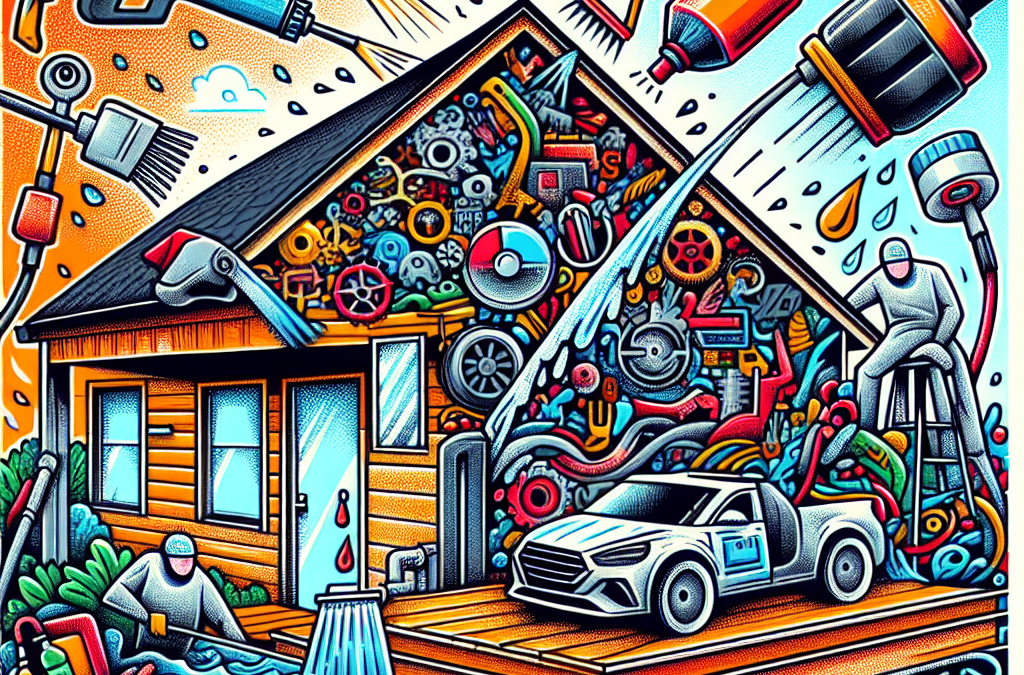Pressure Washing Your Home’s Siding
Pressure washing is an effective way to clean the exterior of your home, including the siding. However, if not done correctly, it can cause damage and lead to costly repairs. To ensure a successful and safe experience, it’s important to know what mistakes to avoid. In this article, we will discuss the common pitfalls to watch out for when pressure washing siding and provide tips on how to properly clean your home’s exterior.
Table of Contents
- Using Too Much Pressure
- Neglecting to Test the Pressure Washer
- Not Using the Right Cleaning Solution
- Ignoring Safety Precautions
- Leaving Streaks and Residue
- Conclusion
Using Too Much Pressure
One of the biggest mistakes people make when pressure washing siding is using too much pressure. While it may seem like more pressure equals better cleaning, it can actually cause significant damage to your home’s exterior. High-pressure water can strip away paint, chip the siding, and even penetrate the walls, leading to water damage and mold growth.
To avoid this mistake, it’s important to use the right amount of pressure for your specific siding material. Vinyl siding, for example, can typically withstand lower pressures, while harder materials like brick or concrete may require a higher pressure. Consult the manufacturer’s guidelines or seek advice from a professional if you’re unsure about the appropriate pressure level.
Neglecting to Test the Pressure Washer
Before you begin pressure washing your siding, it’s crucial to test the pressure washer on a small, inconspicuous area. This will allow you to assess the impact of the water and ensure that it won’t cause any damage to the rest of your siding. Additionally, testing the pressure washer will help you familiarize yourself with its settings and adjust them accordingly to achieve the desired results.
By skipping this step, you risk damaging your siding and creating more work for yourself in the long run. Take the time to perform a test spot and make any necessary adjustments before moving on to the rest of your home’s exterior.
Not Using the Right Cleaning Solution
Another common mistake when pressure washing siding is not using the appropriate cleaning solution. Water alone may not be enough to effectively remove dirt, mildew, and other stains from your siding. Using a specialized cleaning solution designed for pressure washing can help break down grime and improve the overall cleaning process.
However, it’s important to choose the right cleaning solution for your specific siding material. Some cleaners may be too harsh and can damage certain types of siding, while others may not be strong enough to effectively remove stubborn stains. Read the labels carefully and follow the manufacturer’s instructions to ensure safe and effective cleaning.
Ignoring Safety Precautions
Pressure washing can be a hazardous task if proper safety precautions are not followed. When operating a pressure washer, always wear protective gear such as goggles, gloves, and closed-toe shoes to protect yourself from debris and chemicals. Be cautious of your surroundings and avoid pointing the pressure washer at people, pets, or fragile objects.
Additionally, be mindful of electrical hazards when using a pressure washer. Ensure that all cords and electrical connections are properly secured and away from water sources to prevent accidents.
Leaving Streaks and Residue
One of the goals of pressure washing siding is to leave it looking clean and streak-free. However, this can be challenging if proper technique is not employed. One common mistake is leaving streaks and residue behind after pressure washing.
To prevent streaks, start at the top of your siding and work your way down in a consistent, overlapping pattern. This will ensure that the entire surface is evenly cleaned and minimize the chances of streaks or patches. Rinse thoroughly after cleaning to remove any remaining residue and allow the siding to dry completely.
Conclusion
Pressure washing siding can be an effective way to refresh the exterior of your home, but it’s important to avoid common mistakes that can lead to damage or unsatisfactory results. By using the right amount of pressure, testing the pressure washer, using the appropriate cleaning solution, following safety precautions, and employing proper technique, you can achieve a clean and well-maintained siding without any costly mishaps.
Remember, if you’re unsure about any aspect of pressure washing or prefer to leave it to the professionals, don’t hesitate to seek expert advice or hire a reputable pressure washing service. Your home’s exterior will thank you!
Frequently Asked Questions
1. Can I pressure wash my siding without any cleaning solution?
While water alone can remove some dirt and debris from your siding, using a cleaning solution specifically designed for pressure washing can greatly improve the cleaning process. These solutions are formulated to break down grime and stains, making it easier to achieve a thorough clean.
2. How often should I pressure wash my siding?
The frequency of pressure washing will depend on various factors such as the climate, surrounding environment, and the condition of your siding. As a general guideline, it’s recommended to pressure wash your home’s exterior every 1-3 years to maintain its appearance and prevent the buildup of dirt and mildew.
3. Can pressure washing remove paint from my siding?
Using excessive pressure or incorrect technique can potentially strip away paint from the surface. It’s important to use the appropriate pressure level for your specific material and avoid directing the spray at an angle that could cause paint to chip or peel off. If you’re concerned about paint damage, consult a professional or test a small area before proceeding.


Recent Comments